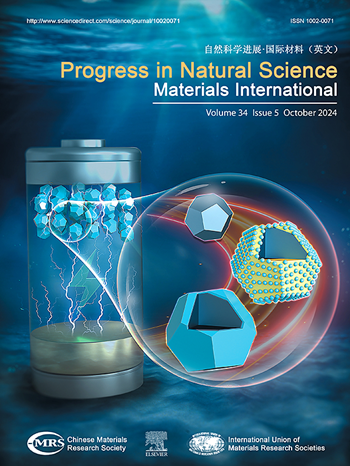Mg2Si、L12-Al3(Sc, Zr)和η′纳米粒子协同强化Al-Mg-Zn-Cu-Si-Sc-Zr合金的激光粉末床熔合
IF 7.1
2区 材料科学
Q2 MATERIALS SCIENCE, MULTIDISCIPLINARY
Progress in Natural Science: Materials International
Pub Date : 2025-04-01
DOI:10.1016/j.pnsc.2025.02.006
引用次数: 0
摘要
在增材制造过程中,Al-Zn-Mg-Cu合金容易开裂。研制了用于激光粉末床熔合的Al-6.2Mg-1.95Zn-0.6Cu-3Si-0.35Sc-0.15Zr-0.4Mn专用合金。Si、Sc和Zr的加入提高了Al-Mg-Zn-Cu合金的可印刷性。该材料的抗拉强度为600 MPa,屈服应力与极限应力之比为0.75。打印样品在熔池边界处呈现出细小的等轴晶和熔池内沿垂直方向的粗柱状晶粒的双峰组织。析出了β-Mg2Si、L12-Al3(Sc、Zr)和η′等多种析出相,形成了高强度铝合金。通过第一性原理计算揭示了Sc、Zn等合金元素的偏析机理,发现Si-Sc原子对在最近邻距离上的结合能高达0.093 eV/对。TEM和DFT结果表明,由3个Cu原子共取代Zn原子形成的η′-Mg (Cu1.5Zn0.5)相具有最低的生成能,是本研究讨论的最稳定的η′相。该研究为激光粉末床熔合制备Al-Zn-Mg-Cu合金的成分改性和析出提供了理论基础。本文章由计算机程序翻译,如有差异,请以英文原文为准。
Laser powder bed fusion of Al-Mg-Zn-Cu-Si-Sc-Zr alloy synergistically strengthened by Mg2Si, L12-Al3(Sc, Zr), and η′ multiple nano-particles
During the additive manufacturing process, Al-Zn-Mg-Cu alloys are susceptible to cracking. A specific Al-6.2Mg-1.95Zn-0.6Cu-3Si-0.35Sc-0.15Zr-0.4Mn alloy was developed for laser powder bed fusion (LPBF) technology. The addition of Si, Sc, and Zr improved the printability of the Al-Mg-Zn-Cu alloy. An excellent tensile strength of 600 MPa and a ratio of yield stress to ultimate stress of 0.75 were obtained. The as-printed sample showed bimodal microstructures with fine equiaxed grains at the molten pool boundary and coarse columnar grains within the melt pool along the vertical direction. Various precipitates, including β-Mg2Si, L12-Al3(Sc, Zr), and η′ were observed, resulting in high-strength aluminum alloys. The mechanism of segregation of Sc, Zn and other alloying elements was revealed by first-principles calculations, and the binding energy of Si-Sc atomic pairs was found to be as high as 0.093 eV/pair at the nearest neighbor distance. The TEM and DFT results revealed that the η′-Mg (Cu1.5Zn0.5) structure, formed by three Cu atoms co-substituting Zn atoms, exhibited the lowest formation energy and represented the most thermodynamically stable η′ phase discussed in this study. This study provided the theoretical foundation for composition modification and precipitation of Al-Zn-Mg-Cu fabricated through laser powder bed fusion (LPBF).
求助全文
通过发布文献求助,成功后即可免费获取论文全文。
去求助
来源期刊
CiteScore
8.60
自引率
2.10%
发文量
2812
审稿时长
49 days
期刊介绍:
Progress in Natural Science: Materials International provides scientists and engineers throughout the world with a central vehicle for the exchange and dissemination of basic theoretical studies and applied research of advanced materials. The emphasis is placed on original research, both analytical and experimental, which is of permanent interest to engineers and scientists, covering all aspects of new materials and technologies, such as, energy and environmental materials; advanced structural materials; advanced transportation materials, functional and electronic materials; nano-scale and amorphous materials; health and biological materials; materials modeling and simulation; materials characterization; and so on. The latest research achievements and innovative papers in basic theoretical studies and applied research of material science will be carefully selected and promptly reported. Thus, the aim of this Journal is to serve the global materials science and technology community with the latest research findings.
As a service to readers, an international bibliography of recent publications in advanced materials is published bimonthly.

 求助内容:
求助内容: 应助结果提醒方式:
应助结果提醒方式:


